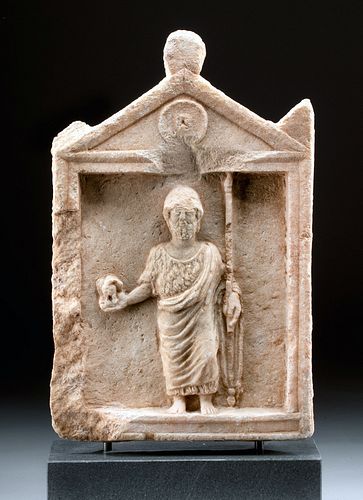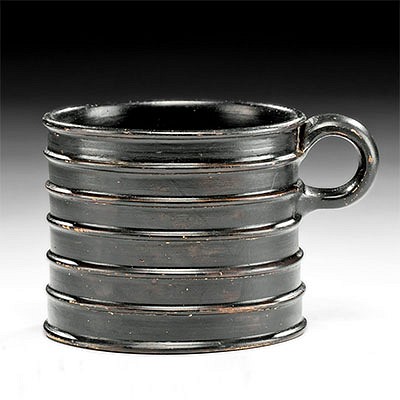Roman Marble Funerary Stele - Temple w/ Male
Lot 47c
About Seller
Artemis Gallery
686 S Taylor Ave, Ste 106
Louisville, CO 80027
United States
Selling antiquities, ancient and ethnographic art online since 1993, Artemis Gallery specializes in Classical Antiquities (Egyptian, Greek, Roman, Near Eastern), Asian, Pre-Columbian, African / Tribal / Oceanographic art. Our extensive inventory includes pottery, stone, metal, wood, glass and textil...Read more
Categories
Estimate:
$7,500 - $11,250
Absentee vs Live bid
Two ways to bid:
- Leave a max absentee bid and the platform will bid on your behalf up to your maximum bid during the live auction.
- Bid live during the auction and your bids will be submitted real-time to the auctioneer.
Bid Increments
| Price | Bid Increment |
|---|---|
| $0 | $25 |
| $300 | $50 |
| $1,000 | $100 |
| $2,000 | $250 |
| $5,000 | $500 |
| $10,000 | $1,000 |
| $20,000 | $2,500 |
| $50,000 | $5,000 |
| $100,000 | $10,000 |
| $200,000 | $20,000 |
About Auction
By Artemis Gallery
Mar 12, 2020
Set Reminder
2020-03-12 10:00:00
2020-03-12 10:00:00
America/New_York
Bidsquare
Bidsquare : Ancient / Ethnographic Around The World
https://www.bidsquare.com/auctions/artemis-gallery/ancient-ethnographic-around-the-world-4957
Ancient art from Egypt, Greece, Italy and the Near East, as well as Asian, Fossils, Pre-Columbian, Native American, African / Tribal / Oceanic, Spanish Colonial, Russian Icons, Fine art, much more! Artemis Gallery info@artemisgallery.com
Ancient art from Egypt, Greece, Italy and the Near East, as well as Asian, Fossils, Pre-Columbian, Native American, African / Tribal / Oceanic, Spanish Colonial, Russian Icons, Fine art, much more! Artemis Gallery info@artemisgallery.com
- Lot Description
Roman, Imperial period, ca. 2nd to 3rd century CE. A beautiful marble funerary stele in the shape of a temple, with an inset rectangular area containing a high relief figure of a bearded man below a triangular pediment. The man stands, facing forward, draped in a flowing himation and wearing a textured chiton. He holds a tall staff in one hand and a small animal in the other - perhaps intended to be a sacrifice. The roof has a round boss set into its center, with a thick border around it; the border extends down to encapsulate the man. Three finials (two remaining) rise from the roof. The figure is nicely detailed, probably representing a mythical character who had special meaning for the deceased. Size: 12.45" W x 19.25" H (31.6 cm x 48.9 cm); 23.2" H (58.9 cm) on included custom stand.
Prior to the 2nd century, Romans cremated their dead; around that time, inspired by the Greek and Etruscan practice of using sarcophagi, they began to place their dead in sarcophagi. This trend spread rapidly throughout the Roman Empire. In the western part of the Empire, which based on the leaf motif this panel probably came from, sarcophagi were placed inside a mausoleum against a wall or in a niche, so the only decorated panels were on the front and the short sides. This stele probably came from the grave of a high-status Roman citizen.
Provenance: private East Coast, USA collection; ex-Artemis Gallery; ex-private New Jersey, USA collection; ex-private German collection, acquired in the 1990s
All items legal to buy/sell under U.S. Statute covering cultural patrimony Code 2600, CHAPTER 14, and are guaranteed to be as described or your money back.
A Certificate of Authenticity will accompany all winning bids.
We ship worldwide and handle all shipping in-house for your convenience.
#149783Surface wear commensurate with age, including some pitting, chips, and nicks. The border is partially lost as is one of the finials. Nice preservation of detail, especially on the face and clothing.Condition
- Shipping Info
-
All shipping is handled in-house for your convenience. Your invoice from Artemis Gallery will include shipping calculation instructions. If in doubt, please inquire BEFORE bidding for estimated shipping costs for individual items.
-
- Buyer's Premium



 EUR
EUR CAD
CAD AUD
AUD GBP
GBP MXN
MXN HKD
HKD CNY
CNY MYR
MYR SEK
SEK SGD
SGD CHF
CHF THB
THB














